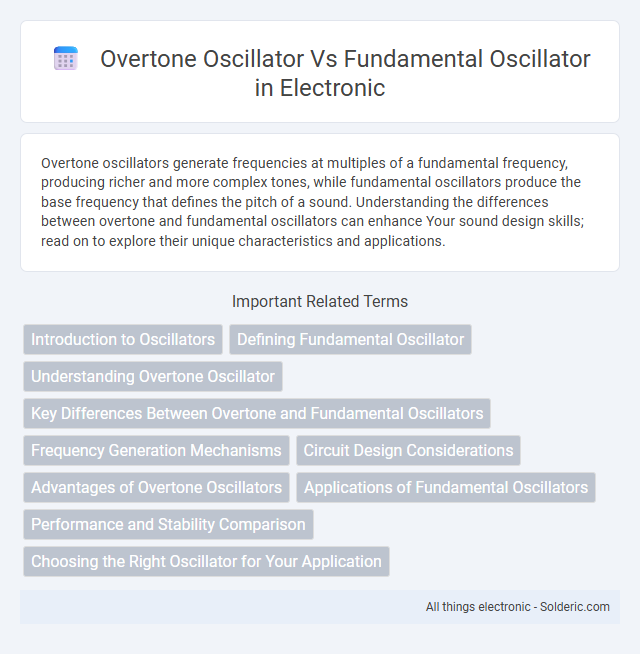Overtone oscillators generate frequencies at multiples of a fundamental frequency, producing richer and more complex tones, while fundamental oscillators produce the base frequency that defines the pitch of a sound. Understanding the differences between overtone and fundamental oscillators can enhance Your sound design skills; read on to explore their unique characteristics and applications.
Comparison Table
| Feature | Overtone Oscillator | Fundamental Oscillator |
|---|---|---|
| Frequency | Higher multiples of the fundamental frequency | Base or lowest frequency of vibration |
| Sound Quality | Rich, complex tones with harmonic content | Pure, simple tones |
| Application | Musical instruments, timbre enhancement | Basic pitch generation, tuning |
| Waveform Complexity | Complex due to multiple harmonics | Simpler, often sine waves |
| Vibration Mode | Higher modes of vibration | Primary mode of vibration |
| Energy Distribution | Energy spread across harmonics | Energy concentrated at fundamental frequency |
Introduction to Oscillators
Oscillators generate periodic waveforms essential in signal processing and electronics, with fundamental oscillators producing the lowest frequency or fundamental tone of a waveform. Overtone oscillators emphasize higher harmonic frequencies, known as overtones, which are integer multiples of the fundamental frequency, enhancing sound richness and tonal complexity. Both types play crucial roles in applications like audio synthesis, communication systems, and precision timing devices.
Defining Fundamental Oscillator
The fundamental oscillator refers to the basic frequency at which an object naturally vibrates, producing the lowest and most dominant tone in a sound wave. This frequency forms the primary pitch heard, serving as the reference point for harmonic analysis and sound synthesis. Understanding the fundamental oscillator is crucial for distinguishing it from overtone oscillators, which generate higher frequency vibrations or harmonics that enrich the sound without changing its perceived pitch.
Understanding Overtone Oscillator
An overtone oscillator generates harmonics or partial frequencies that are integer multiples of its fundamental frequency, producing richer and more complex sounds compared to a fundamental oscillator, which primarily produces a single, pure tone. Understanding overtone oscillators is essential for sound designers and musicians aiming to create textured timbres by manipulating these harmonic layers. Your control over overtone oscillators allows for innovative sound synthesis by emphasizing or attenuating specific harmonics to shape the overall tone.
Key Differences Between Overtone and Fundamental Oscillators
Overtone oscillators generate frequencies at integer multiples of the fundamental frequency, producing harmonic tones that enrich the sound's texture, while fundamental oscillators produce the base frequency that defines the pitch. The overtone oscillator emphasizes higher harmonics, which are crucial for timbre and tonal complexity, whereas the fundamental oscillator sets the primary pitch foundation in audio synthesis. This distinction is essential in sound design, where overtone oscillators add brightness and color, and fundamental oscillators maintain tonal stability.
Frequency Generation Mechanisms
Overtone oscillators generate frequencies by emphasizing higher harmonic modes within a system, producing signals at multiples of a fundamental frequency through nonlinear vibration patterns or resonances. In contrast, fundamental oscillators rely on a primary mode of vibration that corresponds to the lowest natural frequency, enabling stable and predictable frequency output essential for timing and signal processing. Understanding these frequency generation mechanisms helps you select the appropriate oscillator type for applications requiring either precise fundamental frequency or rich harmonic content.
Circuit Design Considerations
Overtone oscillators require carefully designed tank circuits with high Q values and selective filtering to suppress fundamental frequencies and stabilize higher harmonics. Fundamental oscillator circuits prioritize stable resonant elements tuned to the base frequency, often using simpler LC or crystal components without extensive harmonic suppression. Precise component matching and temperature compensation are critical in overtone designs to maintain frequency accuracy, while fundamental oscillators emphasize robust feedback networks for reliable oscillation at the primary frequency.
Advantages of Overtone Oscillators
Overtone oscillators offer higher frequency stability and purity compared to fundamental oscillators, making them ideal for precision applications such as high-frequency communication systems and advanced signal generation. They produce frequencies that are multiples of the fundamental frequency, allowing your circuits to achieve ultra-high-frequency outputs without requiring impractically small quartz crystals. This results in enhanced performance with reduced phase noise and improved frequency accuracy in electronic devices.
Applications of Fundamental Oscillators
Fundamental oscillators are widely used in communication systems, providing stable frequency generation essential for radio transmitters and receivers. They serve critical roles in timing applications such as clock generation in microprocessors and digital circuits, where precision and low phase noise are paramount. Additionally, fundamental oscillators underpin audio signal processing by delivering pure tone generation in musical instrument synthesizers and audio testing equipment.
Performance and Stability Comparison
Overtone oscillators typically offer higher frequency stability due to their operation at multiples of the fundamental frequency, resulting in lower phase noise and improved signal purity. Fundamental oscillators often provide better performance in terms of simplicity and lower power consumption but may suffer from greater frequency drift under temperature variations. Your choice depends on whether you prioritize enhanced frequency precision and stability (overtone) or simplicity and efficiency (fundamental oscillator).
Choosing the Right Oscillator for Your Application
Selecting between overtone and fundamental oscillators depends on frequency stability and application precision. Fundamental oscillators offer lower phase noise and superior frequency accuracy, ideal for high-precision RF communication systems. Overtone oscillators generate higher frequencies from lower crystal modes, suitable for compact designs requiring high-frequency outputs with moderate stability.
overtone oscillator vs fundamental oscillator Infographic

 solderic.com
solderic.com